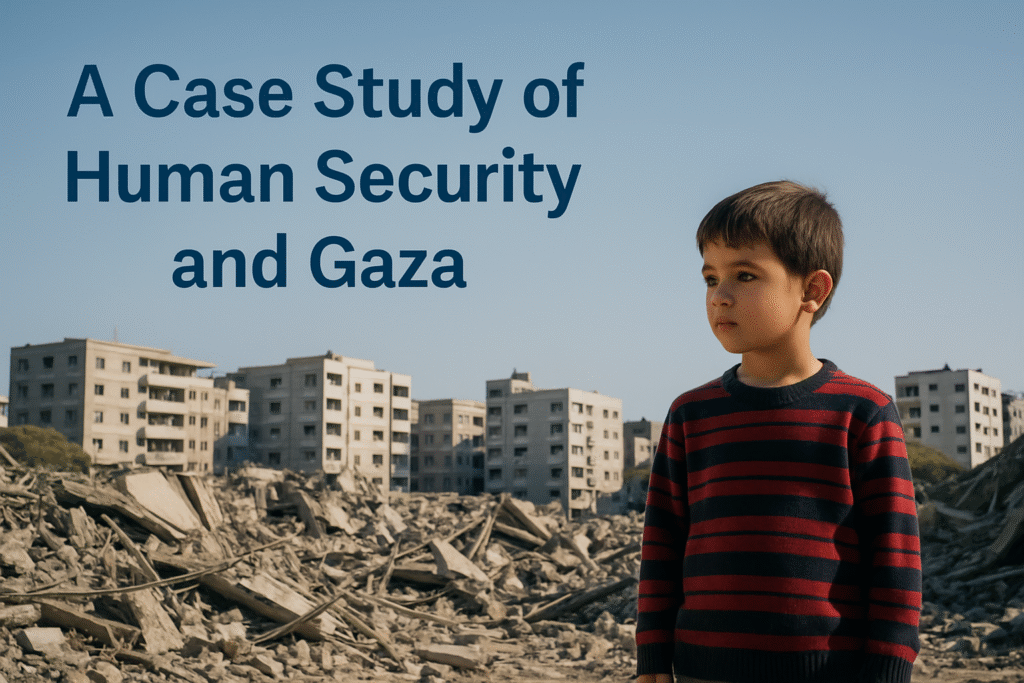By: Priyaranjan Kumar
A few months before, I showed a video their a very small girl on her back inside of a cloth, a small baby like sister goes to the hospital to take medicine during the war in Gaza. and Last week, I wrapped up the UNSSC’s Human Security (HR) Approach: From principles to practices course, and it’s been a game-changer for how I think about complex crises. Instead of “national security,” this course places people at the center, asking: Are our policies really protecting survival, livelihood, and dignity? During this course, I got the opportunity to analyze using this framework, and I chose Gaza to learn what is going on in Gaza. I chose this because Gaza not on Israel because there is also discretion, but we want to understand the principle of HR, how it works in analyzing as a case study. And this is a very dierent case from Yemen, South Sudan, Iraq, and other war zones or conict-aected areas.

The Gaza Strip today stands as a grim testament to the failure of every pillar of human security: virtually every dimension of well-being is shattered under siege. UN agencies warn that Gaza’s economy, infrastructure, and public services are in freefall. For example, in Gaza’s poverty and unemployment have skyrocketed, and GDP has plunged 27% according to UNDP/ESCWA 2024. Likewise, Gaza’s damaged water and waste systems and collapsed sanitation pose an environmental emergency. Against this backdrop, all seven human-security layers (economic, food, health, environmental, personal, community, and political) are collapsing simultaneously in Gaza: for instance, in terms of Economic security: Gaza’s economy has imploded. UNDP/ESCWA data show the Gaza Strip is “left without a functional economy.”. As of mid-2024, roughly 58% of Gazans live in poverty (over 3.2 million people), and GDP is down 27%. Pre-war “hyper-unemployment” (45%) has worsened, with hundreds of thousands of jobs destroyed. Shops, factories, and markets lie in ruins, and nearly every family has lost its livelihood (one report equates war damage to 97% of Gaza’s GDP). Livelihoods are gone: farmers, shermen, and small business owners have no way to earn an income. This economic implosion not only destroys livelihoods but also drives families into deeper hunger. In terms of Food security: Gaza is on the brink of famine. UN monitoring shows about 76% of Gazans now face emergency-or-worse food insecurity (22% in outright famine, 54% at emergency levels). Over 93% of Gaza’s population is classied above “crisis” food-insecurity levels. Hunger is rampant: UNICEF reports thousands of children are treated daily for acute malnutrition (5,119 in May 2025 alone, a 150% jump in a few months and One more example: 1 pack of Parle G biscuit up to 5 rupees in India, but in Gaza, a father buy approximately 2400 for his daughter. This is not only a food issue, it is directly connected with economic), and WHO notes at least 30 Gazans have already died of
hunger. Al Jazeera/IPC data conrm more than 30% of Gaza’s children now suer acute malnutrition, and 57 children have died from malnutrition so far. Widespread shortages mean families skip meals or eat unsafe food; many are reduced to begging or scavenging. I saw a video where, Last month, 7-year-old Lina walked three miles for a single liter of water…Widespread malnutrition then undermines immunity, fueling disease outbreaks across the Strip. And the second pillar of HR is Health security: Gaza’s health system is on the brink of collapse. Fuel shortages and damage have crippled hospitals and clinics. Five major hospitals and dozens of ambulances soon ran out of fuel in May 2024, and the WHO warns that without power, even ventilators and life-support machines fail, so “the whole system collapses.” Only a few hospitals remain functional and are overwhelmed by mass casualties. Disease is spreading: WHO reports that since Oct 2023, over 33,500 diarrhoea cases (half in young children) have been recorded, a massive spike over the pre-war average. UNICEF notes acute watery diarrhea now accounts for 1 in 4 illnesses, and reports suspected hepatitis A outbreaks as clean water disappears. Meanwhile, malnutrition (which weakens immunity) is surging. This is not only concerning of health issues, it also comes from Environmental security: Essential environmental services have failed. UNEP and UN agencies report that sewage and waste management systems have collapsed. Gaza’s ve wastewater plants have shut down, so raw sewage now contaminates beaches, aquifers, and farmland. Garbage collection is almost non-existent – up to 1,200 tons of rubbish pile up daily in camps and streets. Open burning of waste (due to fuel shortages) adds toxic air pollution. In eect, drinking and agricultural water are now routinely polluted. This breakdown has dire knock-on eects: contaminated water contributes to disease outbreaks, and polluted soil undermines future food production. Contaminated water and open dumps become health hazards—but also ashpoints for new displacements as neighborhoods become uninhabitable. If I’m not getting all these securities, it directly impacts on our Personal security: Violence and fear are constant. Nationwide bombardment and incursions forced entire communities to ee: by mid-2025, 90% of Gazans were internally displaced. In one three-month period (Mar–Jun 2025), over 680,000 people ed their homes. Civilians have nowhere safe to hide; UN reports mass-casualty incidents even at aid distribution points, where people seeking food are shot or crushed. According to Gaza’s Health Ministry, 55,000+ people have been killed and 130,000+ injured since Oct 2023. Daily life is terrorized by random shelling and violence. Then, personal becomes Community security: Gaza’s social fabric is being torn apart. Overcrowding and shortages pit neighbors against each other. A senior UN aid ocial notes that Gaza’s “dire living conditions are eroding the social fabric”. Long-standing community networks are strained as families compete for scarce food, water, and shelter. Many displaced families are crammed into makeshift camps or schools, creating tensions. Social services, mosques, schools, and markets that once bonded communities are now overwhelmed or destroyed. Essentially, the war has broken down trust and solidarity: Gazans can scarcely rely on neighbors or institutions for help, compounding the sense of isolation and insecurity. Then it directly
impacts on Political security: No rule of law exists. Governance and justice have collapsed under siege. The Palestinian Authority and Hamas structures were already brittle; now armed groups and occupying forces dominate. Gaza has eectively devolved into a patchwork of rival militias and emergency zones. One analyst warns Gaza is “fragmented, warlord-controlled” and that the result is Gazans “cannot…demand justice”. Israeli checkpoints and military rule mean Gazans cannot access courts or legal recourse, while ad hoc militias dispense punishment. International law is openly outed: WHO has implored all parties to “abide by…international humanitarian law” to protect civilians, highlighting that this is not happening. In practice, civilians in Gaza have nowhere to turn for protection or accountability – neither local authorities nor courts function, so political security is entirely lost. All these layers overlap and reinforce each other. For example, environmental collapse (raw sewage and polluted water) directly causes health crises (diarrhea and malnutrition). Damaged infrastructure means schools and mosques are used as refugee shelters, linking education and personal security. Hunger weakens people, making them more vulnerable to disease and violence. In Gaza’s cramped camps, a lack of work and food drives people to dangerous coping – e.g., risky smuggling or armed groups – entangling economic, personal, and community security. In fact, none of these crises stands alone: they all interact in a vicious cycle. As one observer noted, Gaza’s reality shows human-security dimensions “meet” in unexpected ways (a school serving as a shelter, or a broken water pipe causing illness)..
And yet, what is pain for me is the most glaring apathy of those in power—governments, international bodies, and aid agencies that have the data, the analysis tools, and the moral mandate to act for it. They watch these dimensions and more of human security unravel, fully aware that every bombed school, every collapsed water system, and every starving child could be spared with timely intervention, and still they stall. Too often, responses are calibrated not by humanitarian need but by shifting to geopolitical calculations: decisions hinge on strategic interests, alliances, and donor politics rather than on saving human lives and the next generation. This isn’t mere oversight; it’s a conscious choice to let suering persist, all while proclaiming concern for human rights, which is made by humans. That hypocrisy drives home why the human security framework isn’t just academic, why the UN made this just for reading or for books. I so some of the billions pledged in humanitarian aid, much of the help never reached those who needed it most. Only about 40 percent of food convoys enter designated distribution zones, and roughly 30 percent of water-truck deliveries get to households trapped under siege. Aid agencies report that up to 25 percent of medical supplies remain stuck at checkpoints or in warehouses, while coordination delays and bureaucratic clearances push life-saving assistance weeks behind schedule. As a result, declared assistance gures vastly overstate the real impact, leaving the most vulnerable Gazans still without reliable food, water, or medicines. No side wins when civilians
become collateral damage—proof that human security must come before any geopolitical agenda. If Israel wants to protect itself and spending billions of billions in weapons and thinking about how I can destroy them, then what it mean I’m not supporting Gaza nor Israel, as an Indian, we support humanity and their right, We are not other muslim or other nation, which playing double standards even we are muslim nation if a muslim person or any thing will happen aginst that, that time they will loudly say what happen there see hou human right voilate and other nonsence things. What we say, we say for every human we value human whether they belong to every part of the world. If billions are spent on weapons to destroy, while aid stalls, what does that really protect? Not lives. Not dignity.
Opening safe humanitarian corridors, mandating independent monitoring at checkpoints, and fast-track clearance protocols for food, water, and medicines—ideally via direct-beneciary transfers—could stop much of this needless suering. Give to the freedom to all NGO which is already working there or want to do work under monitoring. These are not distant policy debates but urgent, life-or-death imperatives; human security demands action, not apathy.
As an educator, I’m concerning not about geopolitics and other benets, I have concern for all those children who are away from education and a good life. As an Indian educator and professional, this case study of Gaza taught me how deeply interconnected survival, dignity, and rights truly are. It showed me that security is not just about borders or defense—it’s about food on the table, clean water, access to school, and freedom from fear. I learned how the collapse of one system, like sanitation or education, can quickly trigger failures across others. Most importantly, I realized the power of using data to drive local action. This human security lens will now guide how I teach, analyze crises, and encourage students to see vulnerability and solutions more holistically.
When we come back on HR principles and practice, this framework helps us to understand the macro and micro layers of HR, and how it works in our society.
The data of destruction isn’t just a number; this is human life. I believe it’s a call to hold every actor, whether they are governments, institutions, or aid agencies, accountable to human dignity, not geopolitical games.
